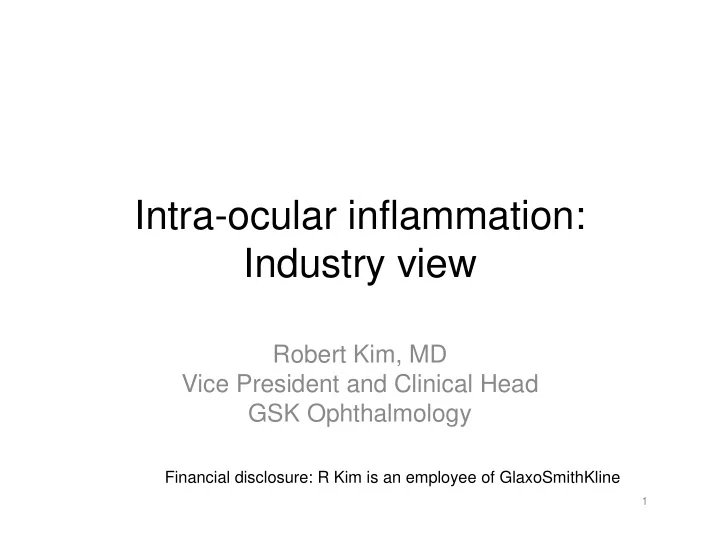

Intra-ocular inflammation: Industry view Robert Kim, MD Vice President and Clinical Head GSK Ophthalmology Financial disclosure: R Kim is an employee of GlaxoSmithKline 1
Outline • Target population • Endpoints • Comparators • Clinical trial design and duration • Managing heterogeneity and rescues 2
Target population • Chronic non-infectious uveitis is an orphan indication affecting < 4.8 in 10,000 persons in the EU 1 • Heterogeneous • Treatment (EU) – Steroids – Ciclosporine – Off-label use of immunosuppressives 1 EMA 3March2010 EMA Public summary of opinion on orphan designation for Novartis antibody to IL-17A. 3
Target population: “Lumping” Emphasis on location and tempo of inflammation 4 SUN working group. Am J Ophthalmol 2005;140:509-51
Target population: “Splitting” Specific entities or characteristics • Behcet’s disease – Recurrent attacks of occlusive vasculitis, systemic • Vogt-Koyanagi-Harada syndrome – Serous retinal detachments, systemic • Birdshot retinochoroidopathy – Electroretinographic abnormalities • Scleritis – Intra-ocular inflammation may be secondary 5
Target patient population A key clinical issue is steroid side effects • Steroids are effective – Eyedrops – Peri- or intra- ocular injections – Oral or intravenous • Challenge is managing steroid side effects with prolonged or 6 recurrent 2011 Ozurdex CHMP assessment
Endpoints Endpoint Comment •Proportion with ≥ 15 letter change ≥ 10 letter change may be Visual acuity •Mean change from baseline in VA score clinically meaningful •Clearing (0) Scale 0, 0.5+, 1+, 2+, 3+, Anterior chamber •Improvement (2-step) 4+ cell Vitreous haze Ozurdex precedent • Worsening (2-step or change from 3+ to 4+) 1 •Elimination of topical or ocular injection Sparing of steroid therapy therapy •Decrease to ≤ 10 mg prednisone equivalent/day 1 Baseline thickness ≥ 260 Reduction in retinal center subfield Macular edema thickness of ≥ 20% 2 µm Recurrence Fewer episodes separated by periods of Alternative is time to inactivity w/o treatment ≥ 3 mos 1 recurrence Inactive disease for ≥ 3 mos after Remission discontinuing all treatment 1 1 SUN working group. Am J Ophthalmol 2005;140:509-516 2 Sugar et al. Am J Ophthalmol 2011 (ePub in press) 7
Clinically meaningful threshold for change in uveitic macular edema evaluated by OCT is 20% 8 Sugar et al. Am J Ophthalmol 2011 (ePub in
Potential endpoint for Immunosuppression: Immunosuppressive load Nussenblatt et al. Ophthalmology 2005;112:764-770 9
Potential endpoint for Scleritis: Scleritis grade Sen et al. Ophthalmology 2011;118:768-7 10
Comparators Current status quo • Typically steroids – Topical, periocular, intravitreal, or systemic – Challenge: Standard of care includes off label use of many medicines • Basic paradigms – Control active disease – New or recurrent – Reduce steroid/immunosuppresive dose(s) required to control disease 11
Clinical trial design and duration • Design – Disease control • Head to head (vs standard of care, usually steroids) – Steroid (or immunsuppressive)-sparing • [Drug + Steroid] vs [Placebo + Steroid] � Steroid taper • Duration – Safety • New indication for previously approved drug : ≤ 1 year • New molecular entity: 1 year • Recommendations for sustained-release formulations will vary – Efficacy – Depends on type of uveitis • Front of the eye inflammation: 3 months • Back of the eye inflammation: 6 months • Special cases, e.g. Behcet’s, Vogt-Koyanagi-Harada: 1 year 12
Managing heterogeneity • Understanding of – Disease pathogenesis – Mechanism of action of drug – Responsive subpopulations • Aspiration: Incorporating such understanding into phase 3 design • Challenge: Knowledge gaps 13
Handling rescued patients • Endpoints of recurrence or remission would be based on rescues • For other endpoints – Dichotomous endpoint, e.g. Responder analysis • Score rescue as failure – Continuous endpoint, e.g. VA score • Intent to treat with last observation carried forward – Sensitivity analysis using per protocol population 14
Summary • Target population – Dealing with heterogeneity: Lumping vs splitting • Endpoints – Multiple endpoints available • Comparators – Typically steroids but may include off label use of medicines • Clinical trial design and duration – Disease control vs steroid (immunosuppressive)-sparing – Duration may depend on type of uveitis and whether or not the drug is a new molecular entity. Sustained release handled case by case. • Managing heterogeneity and rescues – Understand biology - Challenge is knowledge gaps – Rescues can be scored as endpoints themselves or be managed with selection of population and imputation method as appropriate 15
Recommend
More recommend